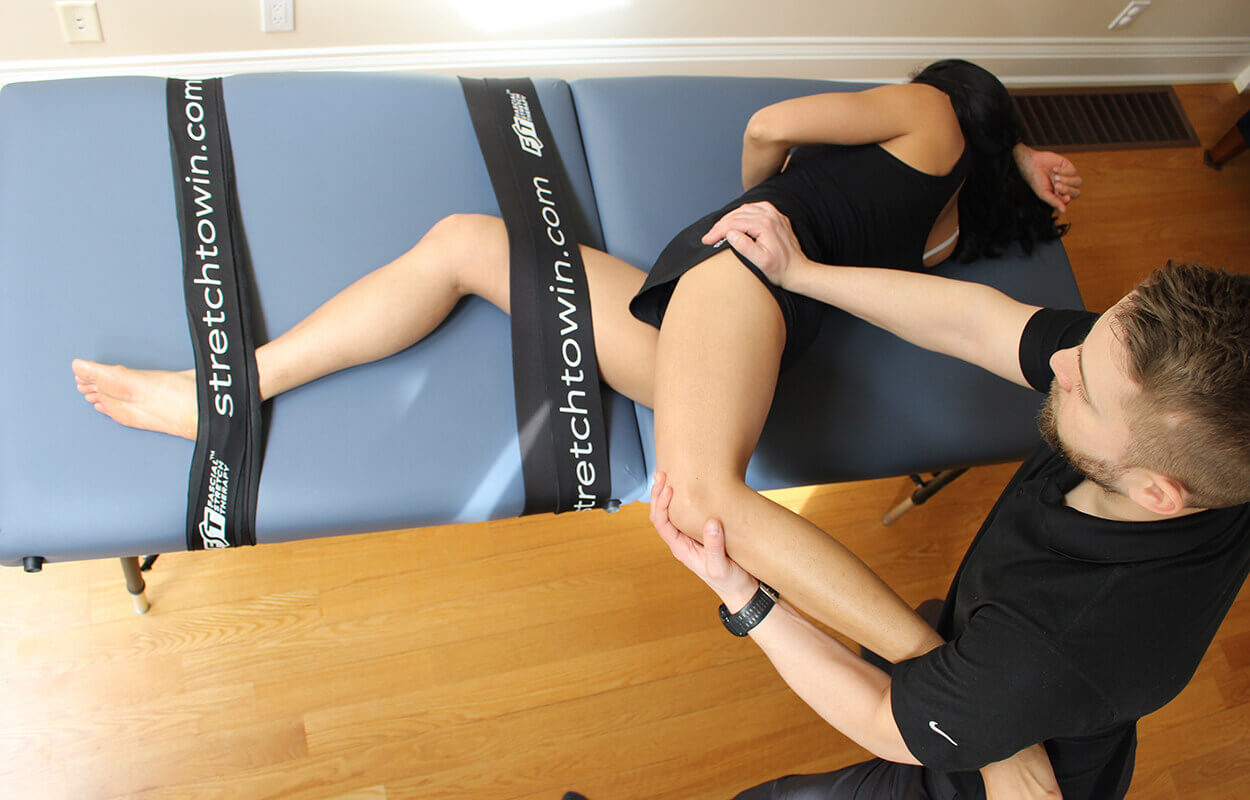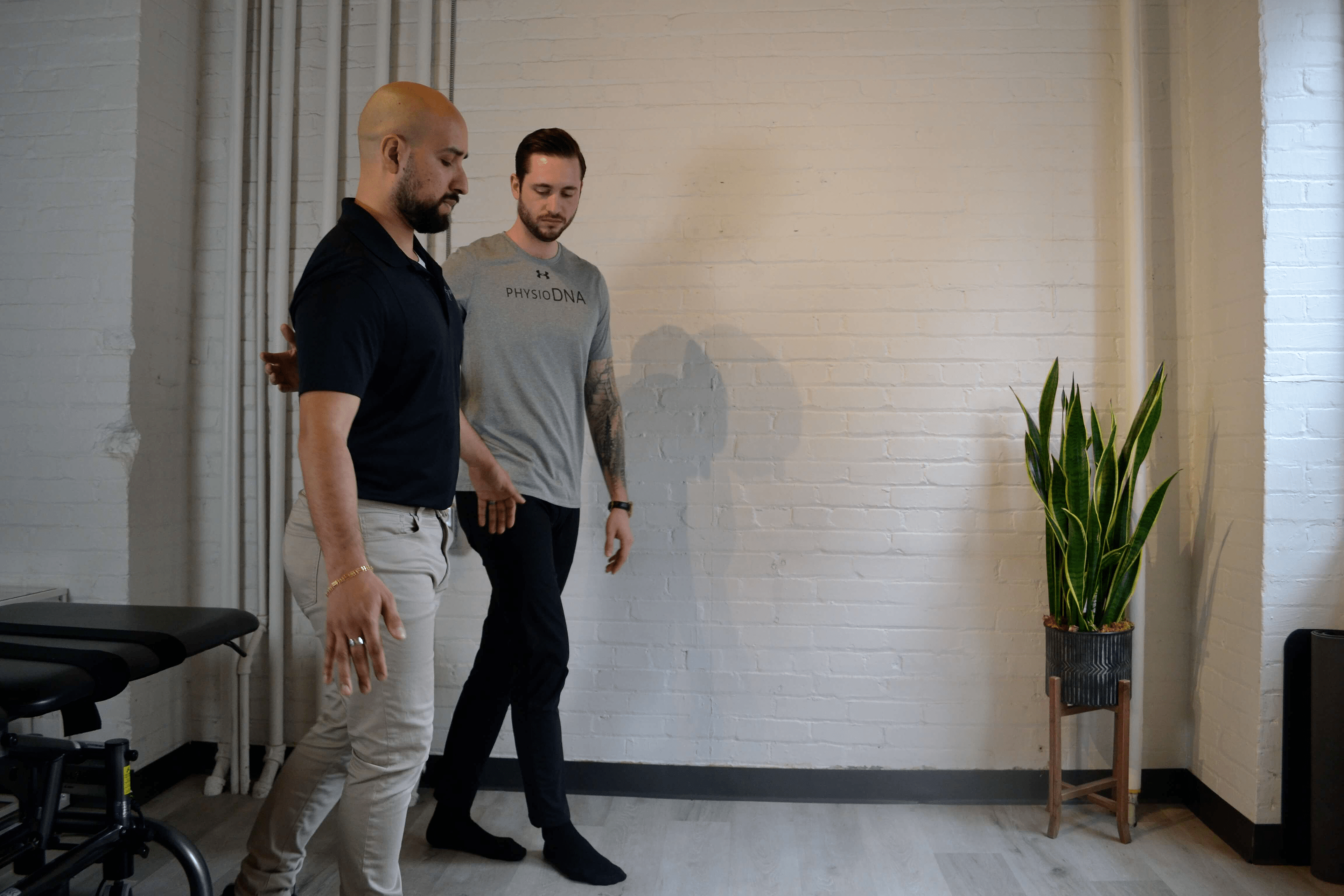
Why Physiotherapy
At PhysioDNA, we strive to help you restore your movement to get back to doing what you love. Our team of skilled physiotherapists create individualized treatment plans to meet your unique goals. Whether you are recovering from a nagging injury, managing chronic pain, or simply looking to optimize your movement and improve your health; our physiotherapists would be happy to help.
Physiotherapy is a healthcare profession focused on helping people decrease pain, improve strength and mobility, and prevent future injuries. At PhysioDNA, our physiotherapists use a combined approach of manual therapy and exercise therapy to remediate impairments and promote better function.
What to expect from our physiotherapy services:
- Assessment: Our physiotherapists will take you through a comprehensive assessment to obtain a detailed history of your injury, observe your movements, and examine all relevant joints and muscles to determine the root of the issue.
- Treatment: We will discuss your goals and work together to develop a treatment plan that meets your needs, which may consist of manual therapy, exercise, education, acupuncture, taping, and other modalities.
- Prevention: After your pain has improved, we want to help you ensure it does not return. We’ll create a long-term exercise plan aimed at keeping you strong and mobile to continue doing the things you love.
Our physiotherapists have experience treating acute and chronic injuries, whether you’ve had a sudden accident or injury or have been dealing with pain for a long time. We specialize in many different areas of rehabilitative care:

- Sports injuries
- Back and neck pain
- Arthritis
- Joint pain
- Work-related injuries
- Balance problems
- And much more!
Our physiotherapy services can help you with a variety of conditions, including:
- Improved pain relief and mobility
- Increased strength and flexibility
- Reduced risk of future injuries
- Enhanced balance and coordination
- Improved overall function and well-being
Benefits of physiotherapy:

WHAT IS ORTHOPAEDIC SPORTS PHYSIOTHERAPY?
Typically this area of physiotherapy focuses on injuries to muscles, joints, tendons, ligaments, and bones. Some of the injuries experienced can be classified as sprains, strains, fractures, overuse, ruptures, swelling, contusions, and more. The causes of such injuries can vary, following an acute or sudden accident or surgery, or can be caused by repetitive or overuse injuries. Some injuries can be chronic and longer lasting, such as osteoarthritis or ankylosing spondylitis (AS). Our highly trained physiotherapists have the experience and skills to work with acute and chronic injuries, creating tailored treatment plans to optimize function, decrease pain, and improve independence.
IS PHYSIOTHERAPY COVERED BY INSURANCE?
If you have extended health benefits insurance through your work or a private insurance plan, you should be able to use these benefits for physiotherapy services at PhysioDNA. You do not need a referral for physiotherapy services at our clinic. Occasionally insurance companies may require that you need a physician’s referral to claim the treatment for reimbursement. Our administrative team can provide you with the necessary support and answer any questions you may have.

Is Physiotherapy Required Before A Surgery And After Surgery?
A pre-rehab program is a crucial step in establishing a positive training routine before surgery and during recovery for better outcomes. Five reasons to undergo physiotherapy before surgery include:
- Strengthening muscles before surgery help you return to your routine quicker, and recovery should be smoother.
- Physiotherapy techniques, especially those incorporating exercise routines, can increase strength and endurance, improving general immunity and making infection less likely.
- Pre-rehab can help lessen current suffering and the likelihood of severe pain after surgery through approaches like exercise, massage, or cold and heat treatments.
- Pre-rehab can improve surgery outcomes and even save money if everything goes smoothly. The stronger you are before surgery, the more likely the surgery will be successful.
- Some patients have found their pre-surgical therapy treatments to be effective enough to cancel their operation. If your health improves significantly after starting physiotherapy, consult your medical team of professionals about future treatment choices and the possibility of avoiding surgery.
Following a successful operation, skilled surgical methods, competent nursing care, and a comprehensive rehabilitation program, Physiotherapy begins in the hospital, when patients are taught how to manage edema, pain, and other complications. Following discharge, a qualified physiotherapist from PhysioDNA can help you achieve your goals and get you back on track. The program begins with a physical assessment of the patient and then identifies the appropriate treatment approach. Postoperative physiotherapy often includes a focus on pain control and tissue healing, with a combination of conditioning exercises, strengthening exercises, and functional rehabilitation. We will collaborate with your surgeon to ensure specific rehabilitation protocol requirements are met.
Some Of Common Types Of Surgeries That Are Seen And Are Treated By Our Practitioners At PhysioDNA Include:
- Elbow and Wrist – Tendon and ligament repair, injection, and fracture
- Shoulder – fracture, rotator cuff repair, arthroscopy, decompression, joint repair, injection
- Hip – Injection, hip replacement, arthroscopy, labral tear
- Knee – ligament, ACL repair, tendon, cartilage, arthroscopy, knee replacement, injection
- Ankle Foot – bunion, fracture, arthroscopy, ligament repair and joint replacement
Everything is dependent on the nature and location of the fracture. Always visit your surgeon or primary care physician to determine whether it is safe to begin physiotherapy. It is important to note that, early intervention prevents complications. Even with simple fractures, physiotherapy may be required to control pain and swelling and to prevent problems associated with immobility. Within a few days of the incident, a safe exercise regimen to avoid deconditioning, strengthen muscles, and reduce stiffness in nearby joints and muscles can begin.

At PhysioDNA, we believe in an approach that focuses on manual therapy and exercise. Manual therapy is a treatment method involving hands-on techniques used to treat acute and chronic conditions, often reducing pain medication use. It restores joint and soft tissue mobility, enhances biomechanics, and results in a healthy body ready for an active lifestyle. Exercise can be used to prevent injury from recurring on a long-term basis. Other hands on techniques also include joint mobilization, Soft Tissue Mobilization (STM), Active Release Technique (ART), and nerve glides, all of which improve joint and tissue mobility, blood circulation, tissue healing, and overall promote a faster recovery.

EXERCISE THERAPY
A physiotherapist is an exercise prescription expert to help patients return to their normal life. After completing education and correcting exercises, our skilled physiotherapists develop a personalized exercise program that clients can perform independently at home or in a facility to complement their weekly visits to the clinic. Functional independence is the ultimate goal in rehabilitation protocols. Research shows that retraining and strengthening muscles optimize function and support joints, preventing re-injury. Exercise therapy consists of stretching exercises for flexibility and mobility, strengthening exercises for postural alignment, aerobic exercises for conditioning, and coordination and balance exercises for overall health.
Related Blogs
FAQs
-
How long does a typical physiotherapy treatment plan last?
A standard physiotherapy treatment program varies with the disorder in focus and may take from a few weeks up to several months. With respect to the treatment of acute injuries, a useful plan may span 4 to 6 weeks, while chronic conditions or post-surgery rehabilitation may take more than a month. Duration is based on deliberate individual monitoring to track the patient’s progress, with physiotherapists regularly assessing the patient to redesign the treatment policy as applicable for the best healing strategy.
-
How does physiotherapy aid in post-surgical recovery?
One of the post-surgery forms of treatment available is physiotherapy, which helps to accelerate the recovery process, improves movement and enhances strength. Patients’ pain relief and the prevention of the development of scar tissue through mobilization and other methods are also the internal objectives of every rehabilitation program. In order to achieve this, a rehabilitation program is designed so that normal activities are gradually reintroduced after the surgery to facilitate the healing process and reduce the risks of complications. After the surgery, physiotherapy treatment is important in stopping muscle wasting and maintaining one’s overall fitness.
-
What types of techniques are used in physiotherapy sessions at PhysioDNA?
At Physio DNA, the physiotherapy treatments employ different techniques as per individual demands, such as manual therapy for hands-on treatment, therapeutic exercises to enhance range of motion and strength and modalities such as ultrasound or electrical stimulation to relieve pain and swelling. There are also soft tissue techniques that include dry needling, cupping, and myofascial release that speed up recovery among patients, creating a more complete form of treatment.
-
Is physiotherapy suitable for all age groups?
Yes, physiotherapy treatments are suitable for all age groups. It can be customized to meet the unique needs of individuals, from children to seniors. Whether it’s helping infants with developmental issues, adults recovering from injuries or surgeries, or seniors managing chronic conditions and improving mobility, physiotherapy offers customized treatments. It focuses on restoring movement, reducing pain, and improving quality of life regardless of age or physical ability.
-
Do I need a doctor's referral to begin physiotherapy treatment?
No, in the majority of cases, a physician’s referral is not necessary before embarking on physiotherapy treatment. A person can schedule an appointment with a certified physiotherapist to commence therapy immediately. Some insurance policies, however, may require a patient to obtain a physician’s referral in order to get reimbursed. This is why it is important to clarify with one’s insurance provider regarding their policy on this matter prior to undergoing treatment. Always speak to the physiotherapy clinic about the particulars.
-
How often should I attend physiotherapy sessions for the best results?
The number of physiotherapy sessions you will need will vary according to your condition and the objectives of your physiotherapy treatment. In most cases, it is recommended to attend sessions one to three times per week to achieve the best results. However, your physiotherapist will evaluate your progress and adjust a plan according to your needs, which may encompass changing the frequency of sessions as well. Regular attendance and adherence to the home exercise program will promote your recovery and significantly improve overall results. Please seek your physiotherapist’s guidance for more specific advice.











